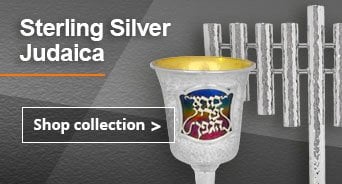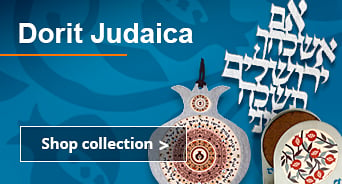6 cm / 2.4 Kosher Mezuzah Scrolls


What Is In A Mezuzah Scroll?
If you ever open up a mezuzah scroll, you will find two Hebrew portions of the Bible written in the traditional Torah writing of a scribe. The first portion (6:4-9) is a command to the Children of Israel to maintain their love for God throughout all their days and the second portion details both the advantages of following God's words as well as the costs of not following the Torah's precepts.
While the text of all mezuzah scrolls is the same, there are slight variations as to how the text is written. Thus, you will find that we offer Ashkenazi mezuzahs (written according to the traditions of Jews of European descent), Sephardi mezuzahs (written according to the traditions of Jews of North Africa, Middle Eastern and Mediterranean descent) as well as Chasidic mezuzahs (written according to the mystical tradition of the 16th century rabbi, the Arizal).
Kosher Mezuzahs Written by Expert Scribes
The Mezuzah is an extremely exact object with dozens of rules governing its production. For example, it must be written on parchment made from a kosher species of animal, such as a cow, a sheep or a goat. Written by hand with a quill made of a feather of a kosher fowl, the scribe must declare his purity of intention before he begins writing and then each time before he writes the name of G-d. Every letter is precise, including the white space surrounding each letter. After the writing is complete, the scroll is checked meticulously by a computer as well as an expert in the field to ensure its Kashrut.
Ashkenazi Mezuzah
Our Ashkenazi Mezuzah is produced according to the dictum of Rabbi Yosef Karo, also known as Beit Yosef, a 16th centrury Rabbi who was responsible for the most recent all-comprehensive transcription of Jewish law. Like all of our Mezuzahs it is completely kosher, written by an expert scribe and proofread by hand and computer.
Chasidi/Ari Mezuzah
We also carry a Chasidi or Ari version which is produced according to the views of the 16th century Kabbalistic Rabbi Isaac Luria (the Ari, or Arizal). It written on uncoated klaf shelil (parchment), and proofread both by hand and by computer.
Sefardic Mezuzah
Finally we have a Mezuzah written in the Sephardic or Velish style. Like our other Mezuzahs it is kosher, written on animal parchment, and proofread both by hand and by computer.
What is a mezuzah?
A mezuzah is a Jewish door ornament that fulfills a commandment and carries a powerful message. It consists of an outer mezuzah case - often beautifully decorated, in a range of possible materials and designs - with a klaf or parchment scroll inside. The mezuzah scroll text, written by a sofer or professional Jewish scribe, contains an excerpt from the Book of Deuteronomy that commands the Jews to hang these words on the doorposts of their homes.
Where to hang a mezuzah
The traditional placement of a mezuzah is on the doorpost of the entrance to one’s home, and on the doorposts of every room except the bathroom. Our store has a range of Jewish mezuzahs that are sturdy enough for the outdoors, in addition to lots of amazing designs for any room in the home, including kid-friendly mezuzah designs for children’s rooms.
Where do you mount a mezuzah? A Jewish mezuzah is affixed on the right doorpost, within the top third of the doorpost.
What side of the door does the mezuzah go on? Traditionally, the mezuzah placement is on the right side of the door, to the right of a person entering the room.
Why is the mezuzah on the right side? The reason for hanging a mezuzah specifically on the right side of the door is that Jewish law assumes most people enter a room with their right foot first, and therefore the mezuzah should be on the side that will be closest to most people passing it by. (The rule is today universal, and one should affix their mezuzah on the right side whether they’re right- or left-handed.)
How to hang a mezuzah
In addition to rules on where to put a mezuzah, Jewish tradition also dictates how to install a mezuzah on the door. For ideal mezuzah hanging, one should use mounting tape or nails in order to affix the mezuzah case to the doorpost, with the mezuzah scroll placed inside. To help you with the proper way to hang a mezuzah on any doorpost, our store sells double-sided adhesive mounting tape here.
According to Ashkenazi tradition, a mezuzah should be slanted at about a 45-degree angle, pointing towards the inside of the room. In Sephardi tradition, meanwhile, the mezuzah placement is usually straight and completely vertical.
Right before attaching the mezuzah to the door, according to Jewish tradition one also recites the proper blessing or prayer.
Prayer for hanging a mezuzah
The mezuzah blessing recited when hanging a mezuzah, also called the mezuzah bracha, praises G-d and references the commandment to put up a mezuzah:
“Blessed are you, L-rd our G‑d, King of the Universe, Who has made us holy with His commandments and commanded us to affix a mezuzah.”
This mezuzah prayer is said by the person hanging the mezuzah, right before affixing it to the door
Why is the mezuzah slanted
If you live in or around an Ashkenazi Jewish community, you’ve probably seen all mezuzahs slanted on doorposts. Why is the mezuzah slanted? It’s a compromise between two opinions that existed in medieval Jewish law: one that the mezuzah should be vertical, and one that it should be horizontal. A conclusion was reached that both opinions should be respected by hanging a mezuzah on a slant.
The mezuzah tilt, therefore, represents unity and compromise in the Jewish tradition.
Which way does a mezuzah lean and what is the mezuzah angle? The mezuzah according to Ashkenazi tradition leans to the right towards the inside of the room. It should be at a slight angle, around 45 degrees or less, whatever the width of the doorpost allows, with the top pointing towards the inside of the door and the bottom pointing outwards.
Sephardi tradition, on the other hand, is to hang the Jewish mezuzah straight and vertical. Both mezuzah placements are commonly seen in Israel today.
Why do you kiss the mezuzah
There is a Jewish tradition to kiss a mezuzah when passing one while walking into a home or room. A mezuzah kiss is not a requirement or commandment, but a folk tradition.
How to kiss a mezuzah? Most people touch the mezuzah first with their right hand and then kiss the tips of the fingers that touched it.
Why do you kiss the mezuzah? There is a Jewish tradition to kiss holy objects, or the fingers or other items that touch them, and a Jewish mezuzah - containing a parchment or mezuzah scroll with holy words of the Torah inside - is one such holy object.
Shin on mezuzah
Many mezuzah cases are adorned with the Hebrew letter Shin, which stands for “Shaddai,” one of G-d’s holy names.
Why does a mezuzah have a Shin on it? The reason for the Hebrew letter Shin on a mezuzah is a reference to the holy name Shaddai, which itself is an acronym for Shomer Daltot Yisrael, "Guardian of Israel's doors". The Shin on a mezuzah therefore refers to G-d’s protection and guardianship over our homes.
Mezuzah meaning / Mezuzah definition
The word “mezuzah” literally means “doorpost.” A mezuzah is a Jewish door ornament that fulfills the commandment for Jews to hang the words of the Bible on their doorposts.
A mezuzah consists of an outer mezuzah case with a klaf or parchment scroll inside. The mezuzah scroll text, written by a professional Jewish scribe, contains an excerpt from the Book of Deuteronomy that specifically mentions the commandment of the mezuzah.
Buy a mezuzah from Israel
Our store carries a wide range of mezuzahs for sale, including beautiful mezuzah cases from Israeli artists and kosher mezuzah scrolls written by trained religious scribes.






